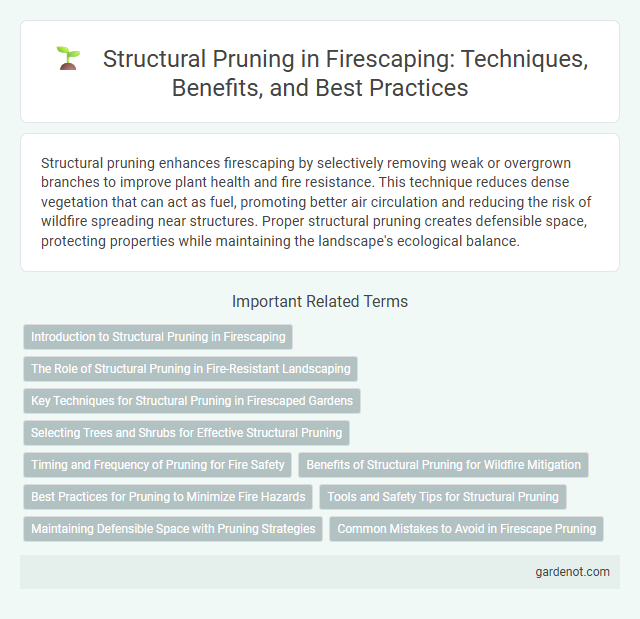Structural pruning enhances firescaping by selectively removing weak or overgrown branches to improve plant health and fire resistance. This technique reduces dense vegetation that can act as fuel, promoting better air circulation and reducing the risk of wildfire spreading near structures. Proper structural pruning creates defensible space, protecting properties while maintaining the landscape's ecological balance.
Introduction to Structural Pruning in Firescaping
Structural pruning in firescaping enhances plant health and fire resistance by selectively removing branches that create dense foliage and ladder fuels. This technique improves airflow and sunlight penetration, reducing the risk of fire spread within and between plants. Proper structural pruning establishes defensible space and supports landscape resilience in wildfire-prone areas.
The Role of Structural Pruning in Fire-Resistant Landscaping
Structural pruning removes lower branches and deadwood, reducing fuel continuity and limiting fire spread near buildings. This technique enhances defensible space by creating vertical and horizontal separation between vegetation layers, which slows fire progression and improves firefighter access. Proper structural pruning maintains plant health while minimizing fire hazards in fire-resistant landscaping designs.
Key Techniques for Structural Pruning in Firescaped Gardens
Structural pruning in firescaped gardens involves precise removal of lower branches and dense foliage to create defensible space and improve fire resistance. Key techniques include thinning to enhance air circulation, reducing ladder fuels to prevent fire spreading from ground to canopy, and maintaining tree health by selectively cutting dead or weak limbs. Employing these methods minimizes potential fuel loads while preserving plant vigor and landscape aesthetics.
Selecting Trees and Shrubs for Effective Structural Pruning
Selecting trees and shrubs for effective structural pruning requires prioritizing species with strong branch attachment and predictable growth habits, such as oaks (Quercus spp.) and maples (Acer spp.). Plants with flexible branches and moderate growth rates respond better to pruning, reducing the risk of branch failure during wildfires. Incorporating fire-resistant native species like manzanita (Arctostaphylos) and ceanothus enhances landscape resilience while supporting structural pruning goals.
Timing and Frequency of Pruning for Fire Safety
Structural pruning for firescaping should be scheduled during the late winter or early spring, before new growth begins, to minimize stress and enhance plant health. Frequency depends on species and growth rate, generally ranging from once to twice annually to maintain clearance and reduce fuel load. Consistent pruning at optimal intervals ensures effective firebreaks and lowers the risk of fire spread around structures.
Benefits of Structural Pruning for Wildfire Mitigation
Structural pruning enhances a tree's resilience to wildfires by removing lower branches and thinning dense foliage, which reduces fuel continuity and limits fire spread. This technique improves canopy health and minimizes the risk of crown fires by creating vertical and horizontal spacing between vegetation layers. Well-executed structural pruning also facilitates better firefighter access and defensible space, increasing safety during wildfire events.
Best Practices for Pruning to Minimize Fire Hazards
Structural pruning involves selectively removing branches to reduce fuel load and enhance tree resilience against wildfires. Best practices emphasize pruning branches up to 10 feet from the ground, removing dead or dying limbs, and maintaining adequate spacing between tree crowns to prevent fire from spreading rapidly. Proper tools, timing during the dormant season, and adherence to local fire-safe landscaping guidelines ensure the effectiveness of pruning in minimizing fire hazards.
Tools and Safety Tips for Structural Pruning
Effective structural pruning requires precise tools such as bypass pruners, loppers, and pruning saws designed for clean cuts that minimize plant stress. Safety tips include wearing protective gloves, safety goggles, and ensuring stable footing to prevent injuries during cutting. Regular sterilization of tools is essential to avoid the spread of tree diseases and maintain plant health.
Maintaining Defensible Space with Pruning Strategies
Structural pruning enhances defensible space by removing lower branches and thinning dense areas, reducing fire fuel near structures. Targeted pruning prevents ladder fuels that allow ground fires to climb into tree canopies, minimizing fire intensity. Maintaining appropriate clearance between vegetation and buildings supports effective firebreaks, improving overall landscape fire resilience.
Common Mistakes to Avoid in Firescape Pruning
Over-pruning during firescaping can weaken tree structure and increase vulnerability to wind damage, reducing the effectiveness of defensible space. Incorrectly cutting too close to the main trunk or leaving large stubs creates entry points for pests and diseases, compromising plant health and fire resistance. Failing to remove ladder fuels properly allows fire to climb into tree canopies, escalating wildfire intensity and threat to structures.
Structural Pruning Infographic

 gardenot.com
gardenot.com